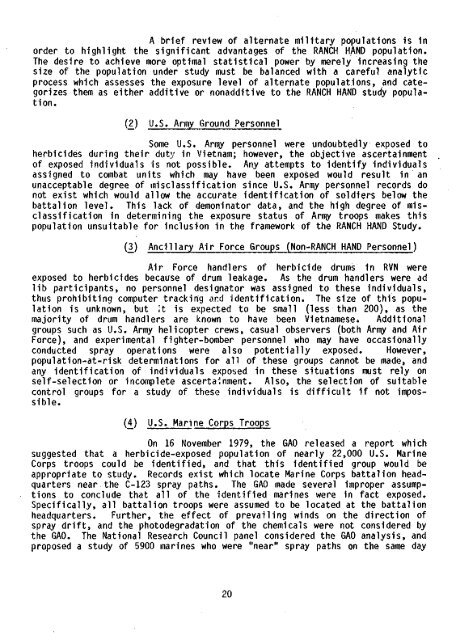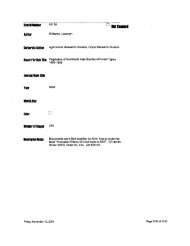Epidemiologic Investigation of Health Effects in Air Force Personnel ...
Epidemiologic Investigation of Health Effects in Air Force Personnel ...
Epidemiologic Investigation of Health Effects in Air Force Personnel ...
Create successful ePaper yourself
Turn your PDF publications into a flip-book with our unique Google optimized e-Paper software.
A brief review <strong>of</strong> alternate military populations is <strong>in</strong><br />
order to highlight the significant advantages <strong>of</strong> the RANCH HAND population.<br />
The desire to achieve more optimal statistical power by merely <strong>in</strong>creas<strong>in</strong>g the<br />
size <strong>of</strong> the population under study must be balanced with a careful analytic<br />
process which assesses the exposure level <strong>of</strong> alternate populations, and categorizes<br />
them as either additive or nonadditive to the RANCH HAND study population.<br />
(2) U.S. Army Ground <strong>Personnel</strong><br />
Some U.S. Arrrjy personnel were undoubtedly exposed to<br />
herbicides dur<strong>in</strong>g their duty <strong>in</strong> Vietnam; however, the objective ascerta<strong>in</strong>ment<br />
<strong>of</strong> exposed <strong>in</strong>dividuals is not possible. Any attempts to identify <strong>in</strong>dividuals<br />
assigned to combat units which may have been exposed would result <strong>in</strong> an<br />
unacceptable degree <strong>of</strong> misclassification s<strong>in</strong>ce U.S. Army personnel records do<br />
not exist which would allow the accurate identification <strong>of</strong> soldiers below the<br />
battalion level. This lack <strong>of</strong> demon<strong>in</strong>ator data, and the high degree <strong>of</strong> misclassification<br />
<strong>in</strong> determ<strong>in</strong><strong>in</strong>g the exposure status <strong>of</strong> Army troops makes this<br />
population unsuitable for <strong>in</strong>clusion <strong>in</strong> the framework <strong>of</strong> the RANCH HAND Study.<br />
(!) Ancillary <strong>Air</strong> <strong>Force</strong> Groups (Non-RANCH HAND <strong>Personnel</strong>)<br />
<strong>Air</strong> <strong>Force</strong> handlers <strong>of</strong> herbicide drums <strong>in</strong> RVN were<br />
exposed to herbicides because <strong>of</strong> drum leakage. As the drum handlers were ad<br />
lib participants, no personnel designator was assigned to these <strong>in</strong>dividuals,<br />
thus prohibit<strong>in</strong>g computer track<strong>in</strong>g and identification. The size <strong>of</strong> this population<br />
is unknown, but it is expected to be small (less than 200), as the<br />
majority <strong>of</strong> drum handlers are known to have been Vietnamese. Additional<br />
groups such as U.S. Army helicopter crews, casual observers (both Army and <strong>Air</strong><br />
<strong>Force</strong>), and experimental fighter-bomber personnel who may have occasionally<br />
conducted spray operations were also potentially exposed. However,<br />
population-at-risk determ<strong>in</strong>ations for all <strong>of</strong> these groups cannot be made, and<br />
any identification <strong>of</strong> <strong>in</strong>dividuals exposed <strong>in</strong> these situations must rely on<br />
self-selection or <strong>in</strong>complete ascerta<strong>in</strong>ment. Also, the selection <strong>of</strong> suitable<br />
control groups for a study <strong>of</strong> these <strong>in</strong>dividuals is difficult if not impossible.<br />
(i)<br />
U'S» Manne Corps Troops<br />
On 16 November 1979, the GAO released a report which<br />
suggested that a herbicide-exposed population <strong>of</strong> nearly 22,000 U.S. Mar<strong>in</strong>e<br />
Corps troops could be identified, and that this identified group would be<br />
appropriate to study. Records exist which locate Mar<strong>in</strong>e Corps battalion headquarters<br />
near the C-123 spray paths. The GAO made several improper assumptions<br />
to conclude that all <strong>of</strong> the identified mar<strong>in</strong>es were <strong>in</strong> fact exposed.<br />
Specifically, all battalion troops were assumed to be located at the battalion<br />
headquarters. Further, the effect <strong>of</strong> prevail<strong>in</strong>g w<strong>in</strong>ds on the direction <strong>of</strong><br />
spray drift, and the photodegradation <strong>of</strong> the chemicals were not considered by<br />
the GAO. The National Research Council panel considered the GAO analysis, and<br />
proposed a study <strong>of</strong> 5900 mar<strong>in</strong>es who were "near" spray paths on the same day<br />
20
















